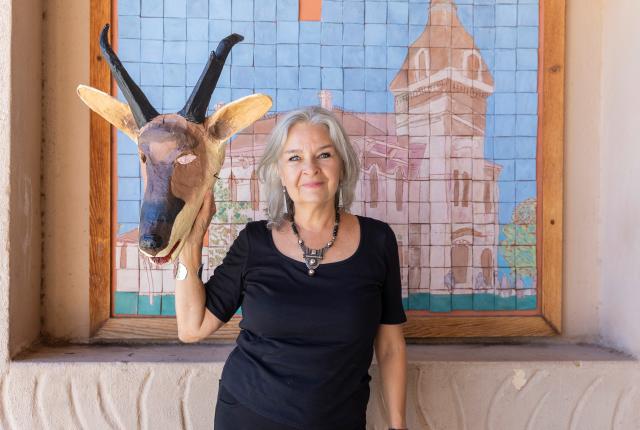DIANA MOLINA THINKS BIG. Copper Canyon huge. Texas large. Border issues massive. “We’re taking this national,” says the La Unión artist behind the traveling multimedia exhibit and book titled Icons and Symbols of the Borderland: Art from the U.S.–Mexico Crossroads. As creative director of the Juntos Art Association, Molina engages artists and writers to represent and reflect on the social and political dynamics along la frontera.
From the part of the Chihuahuan Desert where the Land of Enchantment, Lone Star State, and Republic of Mexico all meet, Molina grew up accustomed to crossing state lines, international borders, and the distance between the two El Paso homes where she was raised. Nothing fenced her in.
“I left as soon as I could,” says Molina, who studied science and worked in robotics and computer automation. But soon enough, the fledgling photographer decided she had to meet the Norwegian nomads she’d heard about. She was raised viewing her parents’ Copper Canyon travel slides and felt the pull to immerse herself in distant cultures until they didn’t seem so foreign. She familiarized herself with new people and began telling their stories, photographing for Marie Claire, Vogue España, and National Geographic Traveler, and exhibiting her work globally.
Upon returning to the borderlands, she was reminded of long-simmering debates over justice, tradition, the environment, and immigration. Molina saw art as a constructive way to exchange perspectives, taking it upon herself to be a moderator and amplifier.
Gathering 35 artists in the Juntos Art Association in 2015, Molina asked each one to provide an interpretation of their family traditions and societal confrontations, incorporating icons and symbols of the European, Indigenous, Mexican, and American experiences. She envisioned an exhibit highlighting common ground in the border region. “The way to go was a traveling exhibit that changes with each showing, depending on the space, new artists, and community engagement,” she says.
“I admire Diana. She works tirelessly. She’s tenacious, industrious, and inspirational.”
While the Icons and Symbols exhibit was seen by more than 3,400 people in Carlsbad, Las Cruces, El Paso, Austin, San Antonio, and Amarillo, the 170 works in a variety of media evolved into a book, which Molina extended into a series of activities that continue the conversation. The most recent focus is on developing arts events along NM 28, in the agricultural corridor between Las Cruces and La Unión. In schools, gardens, breweries, and galleries, as well as online, people blend their voices through music, poetry, literature, performances, and food. “It’s not just the Chicano viewpoint,” she emphasizes.
In August 2024, the project will travel to the James Museum of Western & Wildlife Art, in St. Petersburg, Florida, where it will be on display through January 2025. “Our neighbor Texas and the state of Florida are deep in this immigration issue,” Molina says.
To balance the national message on this “never-ending movement across nations,” Molina formed a coalition, partnering with the Crossroads Art & Ecology Lab and drawing support from the New Mexico Humanities Council and New Mexico Advocates for the Arts, along with individuals.
“I don’t consider myself an artist, but I became a member of the Juntos Art Association,” says Emily Guerra, who highlights border issues through bilingual public radio programming on southwestern New Mexico’s KRWG. “I admire Diana. She works tirelessly. She’s tenacious, industrious, and inspirational.”
TRUE HEROES
Read more about the individuals who went above and beyond to support our communities.


